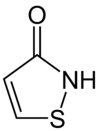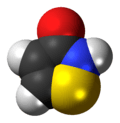Isothiazolinone
| |||
| Names | |||
|---|---|---|---|
| IUPAC name
1,2-Thiazol-3-one | |||
| Other names
Isothiazolin-3-one; 3(2H)-Isothiazolone, isothiazolin | |||
| Identifiers | |||
3D model (JSmol) |
|||
| ChemSpider | |||
| ECHA InfoCard | 100.225.492 | ||
| MeSH | C001490 | ||
PubChem CID |
|||
| UNII | |||
| |||
| |||
| Properties | |||
| C3H3NOS | |||
| Molar mass | 101.127 | ||
Except where otherwise noted, data are given for materials in their standard state (at 25 °C [77 °F], 100 kPa). | |||
| Infobox references | |||
Isothiazolinone (sometimes isothiazolone) is a heterocyclic chemical compound related to isothiazole. Compared to many other simple hererocycles its discovery is fairly recent, with reports first appearing in the 1960s.[1] The compound itself has no applications, however its derivatives are widely used as biocides.
Synthesis
Various synthetic routes have been reported.[2] Isothiazolinones are typically prepared on an industrial scale by the ring-closure of 3-sulfanylpropanamide derivatives. These in turn are produced from acrylic acid via the 3-mercaptopropionic acid.
Ring-closure involves conversion of the thiol group into a reactive species which undergoes nucleophilic attack by the nitrogen center. This typically involves chlorination,[1] or oxidation of the 3-sulfanylpropanamide to the corresponding disulfide species. These reaction conditions also oxidize the intermediate isothiazolidine ring to give the desire product.
Applications
Isothiazolinones are antimicrobials used to control bacteria, fungi, and algae in cooling water systems, fuel storage tanks, pulp and paper mill water systems, oil extraction systems, wood preservation and antifouling agents. They are frequently used in personal care products such as shampoos and other hair care products, as well as certain paint formulations. Often, combinations of MIT and CMIT (known as Kathon CG) or MIT and BIT are used.
Example compounds
- Methylisothiazolinone (MIT, MI)
- Chloromethylisothiazolinone (CMIT, CMI, MCI)
- Benzisothiazolinone (BIT)
- Octylisothiazolinone (OIT, OI)
- Dichlorooctylisothiazolinone (DCOIT, DCOI)
- Butylbenzisothiazolinone (BBIT)
Biological implications
Together with their wanted function, controlling or killing microorganisms, isothiazolinones also have undesirable effects: They have a high aquatic toxicity and some derivatives can cause hypersensitivity by direct contact or via the air.
See also
- Methylisothiazolinone#Other isothiazolinones
- Mercaptobenzothiazole, also a common allergen
References
- 1 2 Crow, Wilfred D.; Leonard, Nelson J. (January 1964). "A synthesis of 3-isothiazolones". Tetrahedron Letters. 5 (23): 1477–1480. doi:10.1016/S0040-4039(01)89515-0.
- ↑ Taubert, Kathleen; Kraus, Susanne; Schulze, Bärbel (April 2002). "Isothiazol-3(2H)-Ones, Part I: Synthesis, Reactions and Biological Activity". Sulfur reports. 23 (1): 79–121. doi:10.1080/01961770208047968.


.png)
.png)